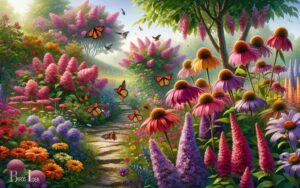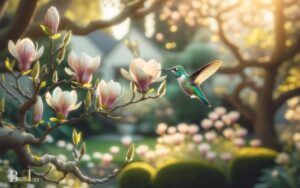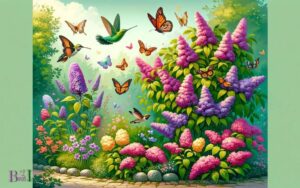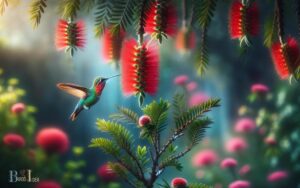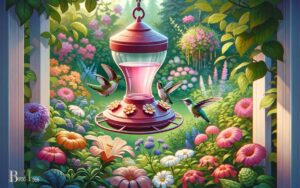Do New Guinea Impatiens Attract Hummingbirds? Yes!
Yes, New Guinea Impatiens are known to attract hummingbirds. These vibrant flowers can be a wonderful addition to gardens designed to invite these tiny birds.
New Guinea Impatiens (Impatiens hawkeri) boast large, colorful blooms and are popular among gardeners looking to add a splash of color to shady spots.
These flowers possess a nectar-rich composition, making them attractive to hummingbirds who are in constant search of high-energy sustenance.
The bright hues of the petals, especially reds and pinks, act as visual lures for hummingbirds.
While they do not have the tubular shape typically associated with traditional hummingbird feeders and flowers, the broad, flat flowers provide an easy landing spot for hummingbirds to feed.
Incorporating New Guinea Impatiens into garden spaces can help create a hummingbird-friendly habitat, thanks to their appealing flowers and nectar offerings.
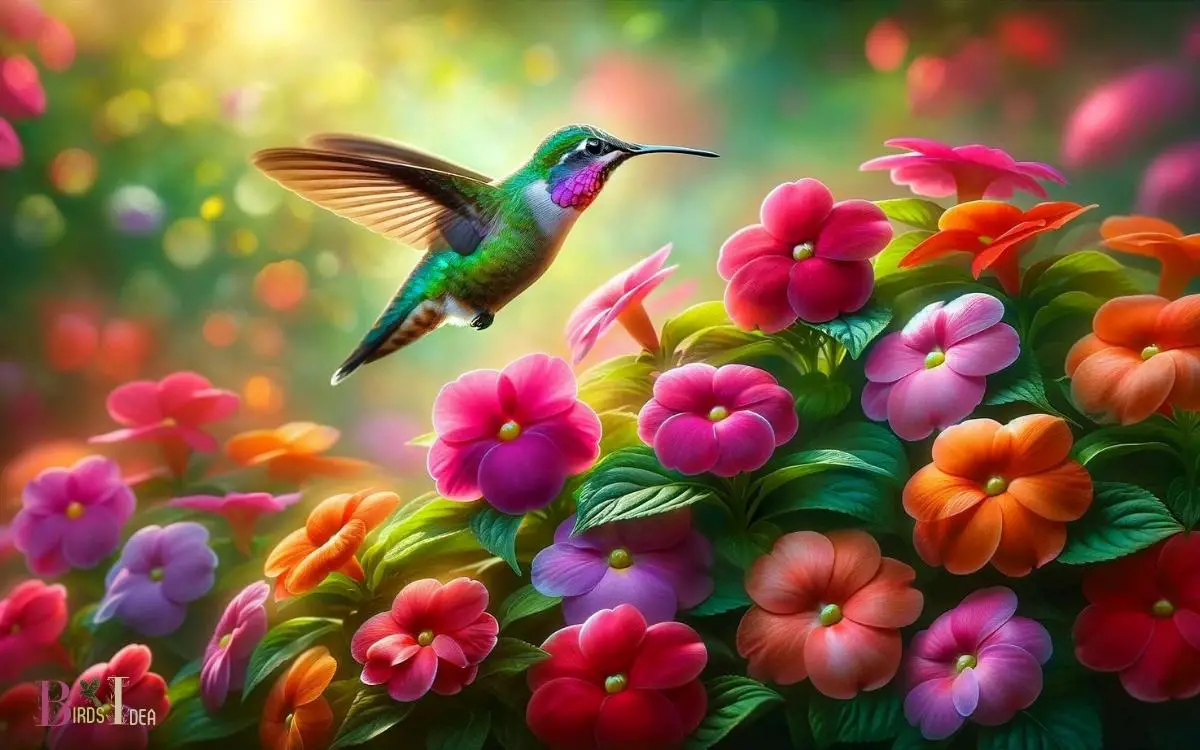
Key Takeaway
Characteristics of New Guinea Impatiens
New Guinea Impatiens are known for their vibrant and long-lasting flowers. These plants, native to New Guinea and the Solomon Islands, are popular for their ability to thrive in partial shade, making them a perfect choice for gardens with limited sunlight.
The flowers come in a wide range of colors, including shades of pink, orange, purple, and white. The leaves are glossy and attractive, providing a lush backdrop to the colorful blooms.
New Guinea Impatiens are relatively low-maintenance and can tolerate a variety of soil conditions, as long as it is well-draining.
Their compact size and bushy growth habit make them an ideal choice for borders, containers, or hanging baskets.
With their striking appearance and adaptability, New Guinea Impatiens are a favorite among gardeners looking to add a pop of color to their landscapes.
Hummingbird Attraction Factors
The factors that contribute to the attraction of hummingbirds to certain flowers are multifaceted and include flower color impact and nectar production level.
Flower color plays a significant role in attracting hummingbirds, as they are particularly drawn to bright, vivid hues such as red, orange, and pink.
Additionally, the level of nectar production in a flower is a critical factor in determining its appeal to hummingbirds, as these birds require high-energy nectar sources to sustain their rapid metabolism.
Flower Color Impact
Hummingbirds frequently prefer brightly colored flowers, which are more likely to attract their attention and encourage feeding. Flower color impact plays a crucial role in attracting hummingbirds.
These birds have excellent color vision, particularly in the red and orange spectrum, and are highly attracted to these colors.
While they can also see blues, purples, and pinks, they show a clear preference for red and orange hues.
This preference is believed to be linked to the color of the flowers they have co-evolved with over time.
Brightly colored flowers signal a high energy reward in the form of nectar, which is essential for the hummingbirds’ high metabolic rate.
Therefore, when planting flowers to attract hummingbirds, opting for vibrant, warm-colored blooms such as red, orange, and bright pink can significantly increase the chances of attracting these delightful birds to your garden.
Nectar Production Level
Impatiens with high nectar production levels naturally entice hummingbirds due to the abundant food source they provide.
Nectar, a sweet liquid produced by flowers, is a vital energy source for hummingbirds. New Guinea Impatiens, with their high nectar production, are particularly attractive to hummingbirds.
The nectar production level is influenced by various factors such as the flower’s genetics, environmental conditions, and plant health.
The quantity and quality of nectar are crucial determinants of a flower’s attractiveness to hummingbirds.
High nectar production not only provides a rich food source for hummingbirds but also increases the likelihood of repeated visits, aiding in plant pollination.
Therefore, the nectar production level of New Guinea Impatiens plays a significant role in attracting and sustaining hummingbird populations in a garden or natural habitat.
New Guinea Impatiens and Hummingbird Behavior
New Guinea Impatiens have been observed to play a significant role in hummingbird behavior, particularly in attracting them.
The vibrant colors and nectar-rich flowers of New Guinea Impatiens are known to entice hummingbirds, making them a valuable resource for these avian pollinators.
Understanding the interaction between New Guinea Impatiens and hummingbirds sheds light on the plant’s potential role in supporting hummingbird populations and the broader ecological dynamics of their foraging behaviors.
Impatiens and Hummingbird Interaction
In the spring and summer, New Guinea Impatiens often attract hummingbirds with their bright, nectar-rich blooms.
The interaction between New Guinea Impatiens and hummingbirds is fascinating and has been the subject of scientific study.
Here are some interesting aspects of this interaction:
- Visual Attraction: Hummingbirds are attracted to the vibrant colors of New Guinea Impatiens, particularly shades of pink, orange, and red.
- Nectar Feeding: Hummingbirds are drawn to the abundant nectar produced by New Guinea Impatiens, providing them with a vital food source.
- Pollination: As hummingbirds feed on the nectar, they inadvertently transfer pollen from one flower to another, aiding in the plant’s reproduction.
- Behavior Observation: Studying hummingbird behavior around New Guinea Impatiens can provide insight into their foraging patterns and preferences.
Understanding these aspects of impatiens and hummingbird interaction can deepen our appreciation for the symbiotic relationship between these beautiful flowers and these remarkable birds.
Impatiens as Hummingbird Food
The hummingbird’s behavior towards New Guinea Impatiens suggests a strong preference for the flower’s nectar, raising questions about its potential role as a substantial food source for these birds.
Several observations support this notion:
- Feeding Patterns: Hummingbirds have been observed visiting New Guinea Impatiens flowers regularly, indicating a reliance on the nectar provided by these blooms.
- Energy Intake: The high sugar content of New Guinea Impatiens nectar can serve as a valuable energy source for hummingbirds, supporting their metabolic needs during periods of high activity.
- Foraging Behavior: Hummingbirds exhibit distinct foraging behaviors when interacting with New Guinea Impatiens, further indicating a specialized interest in accessing the nectar within these flowers.
- Floral Characteristics: The specific shape and nectar accessibility of New Guinea Impatiens may align with the feeding capabilities and preferences of hummingbirds, making it a potentially important food source for these avian species.
Tips for Creating a Hummingbird-Friendly Garden
To create a hummingbird-friendly garden, gardeners should focus on selecting nectar-rich flowers and providing suitable perches for the birds to rest.
Nectar-producing plants such as bee balm, salvia, and trumpet vine are excellent choices for attracting hummingbirds.
These flowers have tubular shapes that accommodate the long bills of hummingbirds and provide ample nectar.
Additionally, incorporating a variety of flower colors, especially reds, oranges, and pinks, can further attract these avian visitors.
It is also essential to include shrubs and trees for perching and nesting. Providing a water source, such as a shallow birdbath, can further enhance the garden’s appeal to hummingbirds.
By creating a diverse and nectar-rich environment with suitable perches, gardeners can attract and support these delightful birds in their gardens.
Planting and Caring for New Guinea Impatiens
New gardeners can enhance their hummingbird-friendly gardens by incorporating New Guinea impatiens to provide additional nectar sources for these delightful birds.
Planting and caring for New Guinea impatiens is relatively straightforward, making them an excellent choice for both novice and experienced gardeners.
Here are some essential tips for planting and caring for New Guinea impatiens:
- Location: Choose a well-draining area with partial shade for planting New Guinea impatiens.
- Soil: Use rich, fertile soil with good organic matter content to ensure healthy growth.
- Watering: Keep the soil consistently moist, but not waterlogged, to support optimal growth and flowering.
- Fertilization: Apply a balanced, water-soluble fertilizer every 2-3 weeks during the growing season to promote vigorous blooming.
With proper planting and care, New Guinea impatiens can thrive and provide a wonderful nectar source for hummingbirds.
Other Plants to Attract Hummingbirds
One of the most effective ways to attract hummingbirds is by planting a variety of nectar-rich flowers in the garden.
Some of the best plants to attract these colorful birds include trumpet vine, bee balm, salvia, cardinal flower, and columbine.
- Trumpet vine, with its vibrant orange flowers, is particularly attractive to hummingbirds due to its copious nectar production.
- Bee balm, available in various colors, provides a long blooming season and is a favorite among hummingbirds.
- Salvia, with its tubular flowers, is rich in nectar and a popular choice for attracting these avian pollinators.
- Cardinal flower, with its striking red blooms, is also highly appealing to hummingbirds.
- Columbine’s unique, spurred flowers produce nectar that hummingbirds find irresistible.
By incorporating these plants into the garden, one can create a haven for hummingbirds.
Conclusion
It is evident that New Guinea Impatiens can attract hummingbirds to your garden through their vibrant colors, nectar-rich flowers, and long blooming period.
By understanding the behaviors and preferences of hummingbirds, gardeners can create a welcoming environment for these fascinating creatures.
With proper care and maintenance, New Guinea Impatiens and other hummingbird-friendly plants can create a “buzz” of activity in your garden, providing a delightful spectacle for any bird-watching enthusiast.


